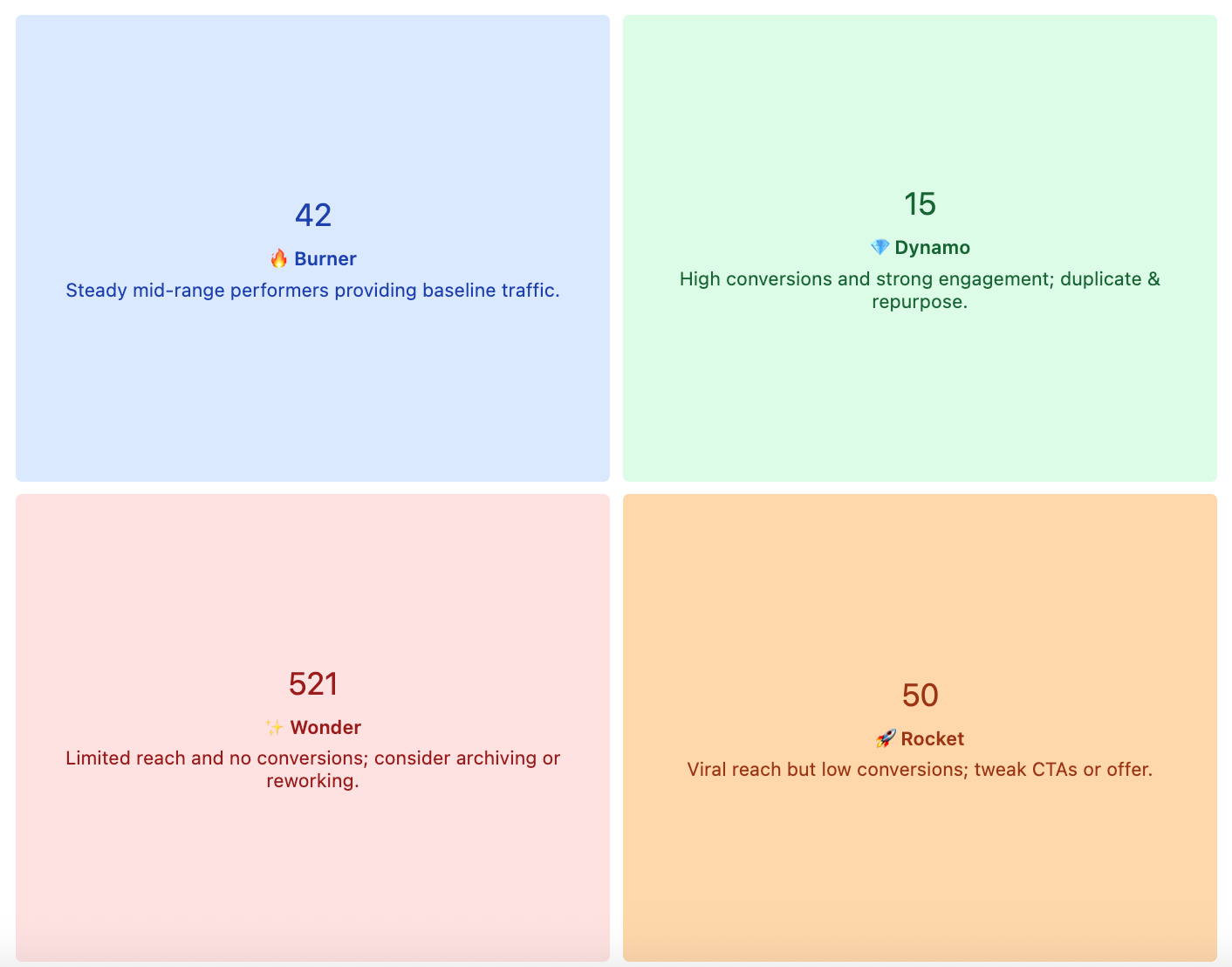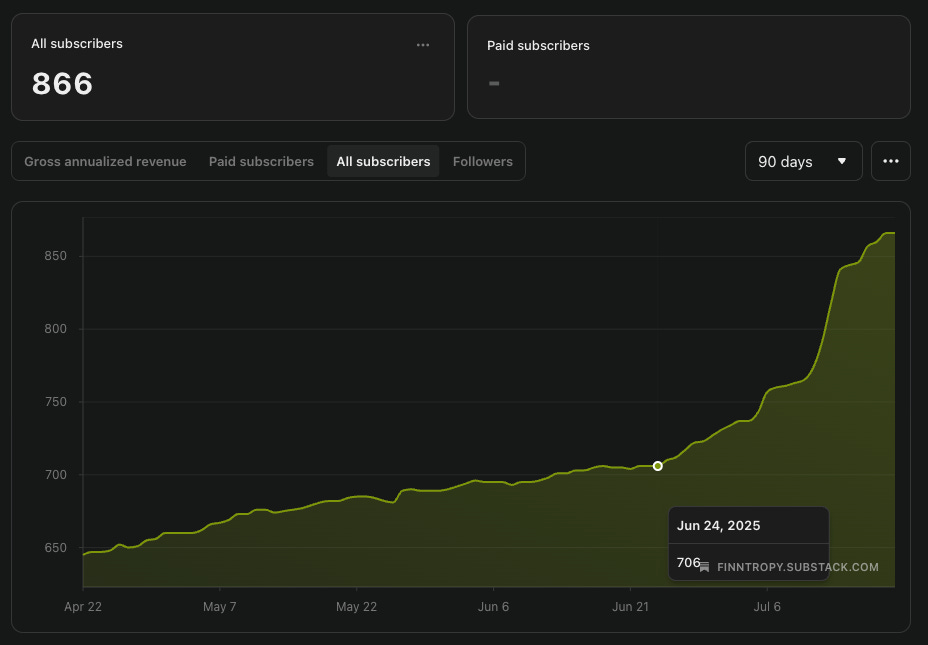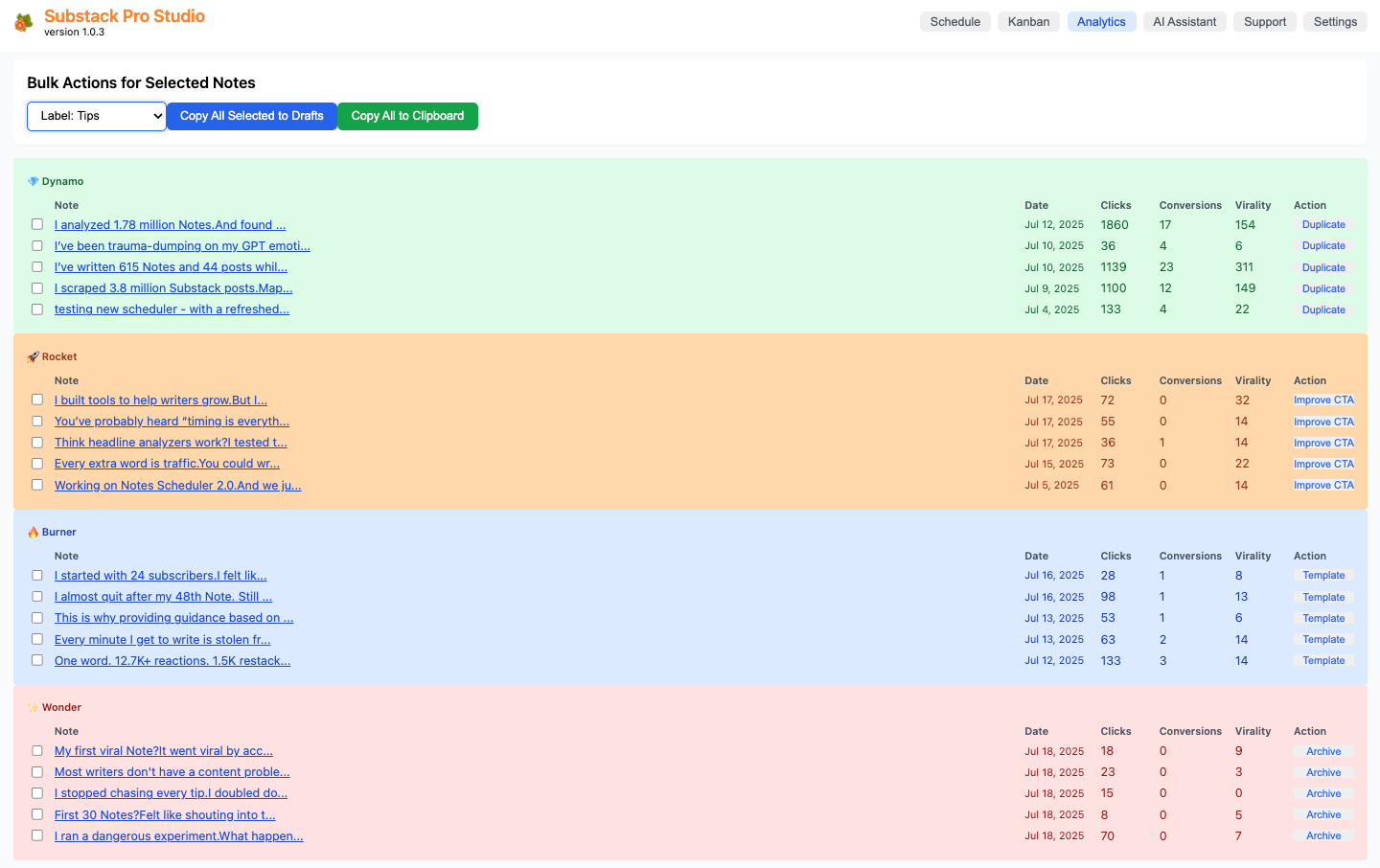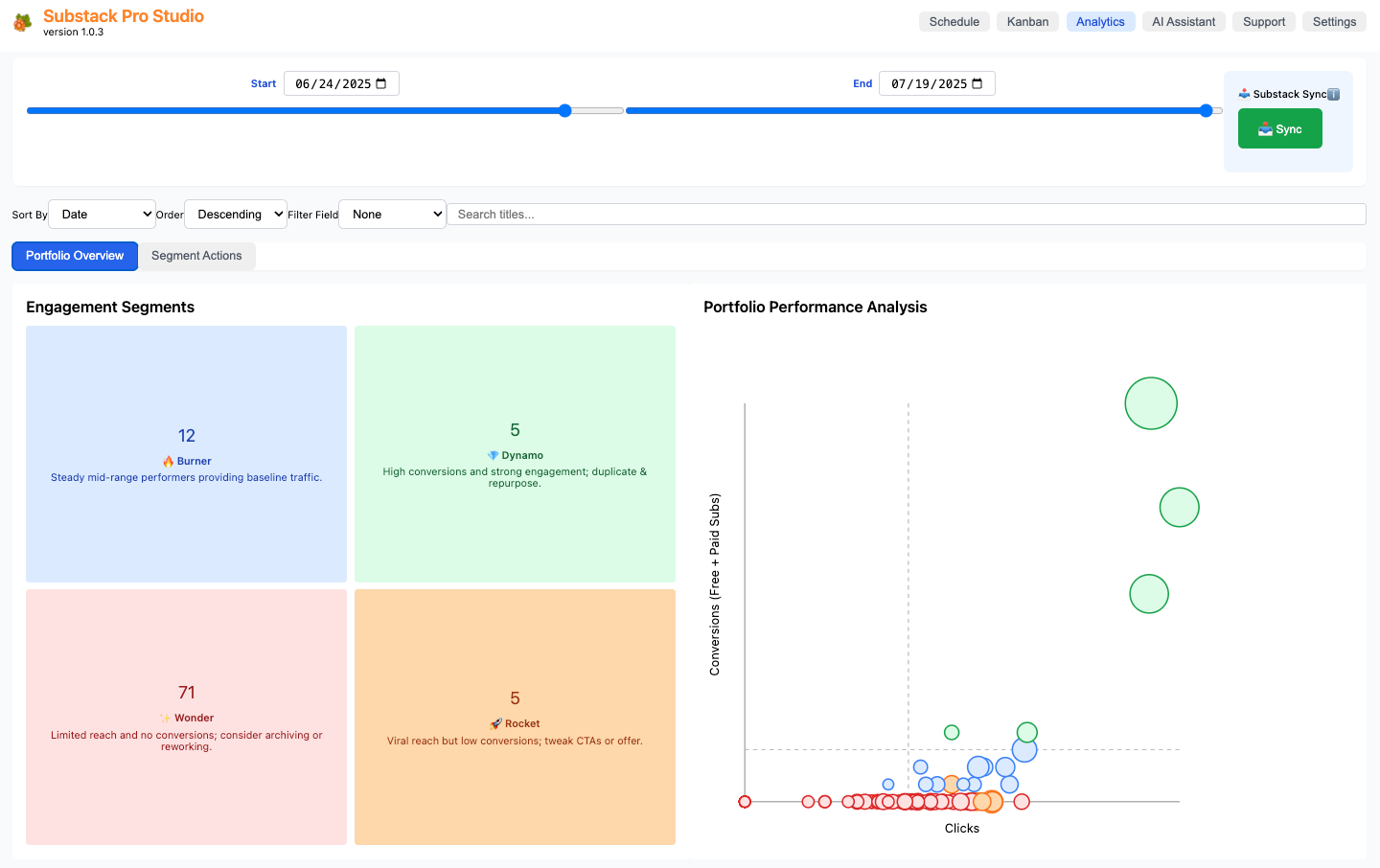How Treating Notes Like a Portfolio Unlocked 22% Subscriber Growth in 27 Days
Turn everyday Notes into powerful growth experiments - here’s how
Most writers treat Substack Notes like they treat socks from the dryer - mismatched, forgotten, and probably not worth organizing.
I used to do the same.
But then I stopped treating Notes like throwaway content and started treating them like a portfolio of tiny startup experiments.
The result?
22% subscriber growth in 27 days.
Zero extra writing time.
Just smarter deployment.
Let’s unpack what changed.
The Problem: Notes Are Easy to Ignore
If you’re a writer or solopreneur on Substack, chances are you’ve whispered one of these into the void:
“No one reads my Notes.”
“I post every day, and nothing moves.”
“Why did that random Note go viral while my favorite one flopped?”
“Am I just shouting into a stylishly designed void?”
You're not alone.
Most writers publish Notes like lottery tickets - hoping one hits, then forgetting the rest.
Growth feels random, and watching others skyrocket with less effort?
It’s demoralizing and suspicious.
Rethinking Notes: From Stream-of-Consciousness to Signal
I used to treat Notes the way most writers do:
A place for loose thoughts, quick shares, and the occasional witty one-liner.
However, after months of trial and error, with wildly inconsistent results, I needed a clearer lens.
I created the Note Portfolio Framework—a simple way to stop lumping all Notes together and start seeing patterns.
Here’s the breakdown
🔥 Slow Burners — They don’t go viral, but they consistently drive quiet engagement. Often overlooked, but they compound.
💎 Dividend Dynamos — Rare and valuable. These Notes get solid engagement and lead to new subscribers.
✨ One-Hit Wonders — Flashes of personality or novelty that get a few likes and then vanish. Still worth studying.
🚀 Launch Rockets — Big numbers, zero conversions. Great for reach, bad for results. Fixable with a clear next step for readers.
I didn’t invent this idea overnight.
The seed was planted months ago when I applied a similar framework to my Medium posts. Then I tried it on my long-form Substack pieces, and the same patterns jumped out again.
But it was Rob Fitzpatrick’s Write Useful Books that helped me see it clearly:
Test your book with real readers, even before it has been written.
Put it out there for feedback before it feels ready. Use beta readers. Fall in love with negative feedback. Iterate and improve. — Rob Fitzpatrick
That’s when it clicked:
Notes aren’t just tiny posts. They’re testable ideas.
Each Note is an experiment.
And experiments, if taken seriously, give you the kind of feedback that actually makes you better, not just louder.
Why Segmentation Works (Even If You Use AI)
Let’s be honest.
If you’ve been burned by promises of “AI-powered growth hacks,” your guard’s up. Rightfully so.
However, segmentation isn’t just a shiny trick.
It’s a methodical way to cut through your own content fog and use data to make creative decisions with more precision.
Here’s what it looks like in practice:
🚀 A Note goes viral, but doesn’t convert subscribers? That’s not a win — it’s a signal your story drew people in, but your next step lost them.
💎 Another Note receives fewer likes but quietly drives over 15 new subscribers? That’s a keeper. Time to unpack why it converted and try a variation.
✨ One Note completely flopped? That’s okay. Archive it or tweak the framing. Not every swing is a home run.
This isn’t about replacing your creative instincts with charts and metrics.
It’s about not flying blind.
And yes, AI can help - not by writing for you, but by isolating patterns.
Why do certain notes always underperform? Does a looser tone tend to boost engagement? Is there a structure that consistently converts?
You don’t need to run split tests or obsess over every variable.
But you do deserve to know what’s working and what isn’t — so you can write with more clarity and intention.
Segmentation isn’t some growth hack.
It’s just treating your work with the same respect a product team gives to their features:
Tested, iterated, and aligned with a purpose.
The Experiment: A 22% Lift Without More Output
Growth claims are easy to make. But what actually changed?
Here’s what I saw:
📅 June 24: 706 subscribers
📅 July 20: 866 subscribers
That’s +160 subs in 27 days — a 22% month-over-month increase
No viral threads. No paid traffic.
Same ~4 hours of writing per week.
So what did change?
I stopped treating Notes as one-offs.
I started tagging each Note by type — was it meant to spark engagement, drive clicks, or test a new idea?
I tracked outcomes weekly — which Notes converted? Which just got clicks?
I recycled proven formats, headlines, and next steps — not copying and pasting, but remixing with intention.
This wasn’t about working harder or chasing hacks.
It was about treating each Note like a micro-experiment.
And finally, giving myself a feedback loop I could actually learn from.
It’s not magic. It’s not scale-at-all-costs.
It’s what happens when you stop publishing in the dark.
Isn’t This Just Chasing Metrics?
Here’s the unpopular truth:
Chasing metrics and being authentic aren’t opposites.
They only feel that way because we’ve been sold a bad binary:
“You’re either pure and spontaneous or you’re a sellout optimizing for clicks.”
That’s nonsense.
What’s more honest than wanting your work to reach people?
What’s more respectful to your readers than testing what actually lands with them — and adjusting accordingly?
“Authenticity” isn’t posting whatever you feel in the moment and hoping for applause.
And “strategy” isn’t inherently manipulative. It’s just paying attention.
Metrics don’t corrupt the work. They clarify it.
They show you what’s sticky, what’s confusing, and what gets ignored.
The real danger isn’t looking at numbers.
It’s ignoring feedback under the guise of staying “true to yourself.”
If your “authentic voice” is a mystery even to your audience, who exactly is it serving?
Metrics don’t tell you who to be.
But they can tell you when you’re actually being heard.
And if that’s not the goal, what is?
Want to Try This Yourself?
Here’s how to get started in 3 steps:
Segment your Notes weekly into the 4 types (🔥 💎 ✨ 🚀)
Track your metrics like virality (reactions+restacks+comments) & conversion
Recycle your Dynamos. Reframe your Rockets. Reflect on your Wonders.
And a bonus pro tip?
Start every week by reading your bottom 5 Notes.
That’s where most of your hidden gems (and growth insights) are buried.
Notes Are Feedback Loops, Not Throwaways
It’s tempting to treat Notes as digital scraps: quick thoughts, stray links, filler between “real” posts.
But every Note is a signal. Not just from your audience, but from your own creative process.
Some Notes spark conversation. Others slip by quietly. A few might flare up and fade. But each one leaves a trace: a clue about what resonates, what needs refining, and what’s worth a second look.
The real mistake isn’t writing Notes that go unnoticed. It’s assuming their value ends once you hit “post.”
Growth doesn’t come from churning out more content. It comes from paying attention to what’s already working and doubling down with intent.
Notes aren’t shots in the dark. They’re conversations you can return to, learn from, and build on.
That’s how growth becomes earned, not accidental.











Thank you so much for sharing this. Your insights are invaluable. Im definitely going to put your words into practice. Love and light sent your way. 🌙💫
Oh yes!